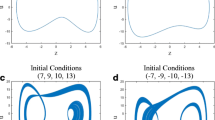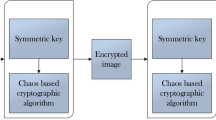Abstract
Today, medical imaging suffers from serious issues such as malicious tampering and privacy leakage. Encryption is an effective way to protect these images from security threats. Chaos has been widely used in image encryption, the majority of these algorithms are based on classical chaotic systems. For now, these systems are easy to analyze and predict, which are not sufficient for image encryption proposes. In this paper, a novel fourth order chaotic system is proposed, accompanied by analysis of Lyapunov exponent and bifurcations. Finally, the application of this system with medical image encryption is proposed. As this system could have six control parameters and four initial conditions, the key space is far greater than 5.1 × 218191, which is large enough to resist brute force attack. Correlation analysis and differential attack analysis further demonstrate that this scheme has a strong resistance against statistical attacks and differential attack.












Similar content being viewed by others
Explore related subjects
Discover the latest articles, news and stories from top researchers in related subjects.References
Ahmed, H. U., Bosaily, A. E. S., Brown, L. C., et al. (2017). Diagnostic accuracy of multi-parametric MRI and TRUS biopsy in prostate cancer (PROMIS): A paired validating confirmatory study. The Lancet, 389(10071), 815–822.
Albisinni, S., Artigas, C., Aoun, F., et al. (2017). Clinical impact of 68 Ga-prostate-specific membrane antigen (PSMA) positron emission tomography/computed tomography (PET/CT) in patients with prostate cancer with rising prostate-specific antigen after treatment with curative intent: preliminary analysis of a multidisciplinary approach. BJU International, 120(2), 197–203.
Arroyo, D., Hernandez, F., & Orúe, A. B. (2017). Cryptanalysis of a classical chaos-based cryptosystem with some quantum cryptography features. International Journal of Bifurcation and Chaos, 27(01), 1750004.
Bruining, D. H., Zimmermann, E. M., Loftus, E. V., Jr., et al. (2018). Consensus recommendations for evaluation, interpretation, and utilization of computed tomography and magnetic resonance enterography in patients with small bowel Crohn’s disease. Gastroenterology, 154(4), 1172–1194.
Cao, W., Zhou, Y., Chen, C. L. P., et al. (2017). Medical image encryption using edge maps. Signal Processing, 132, 96–109.
Chen, G., Mao, Y., & Chui, C. K. (2004). A symmetric image encryption scheme based on 3D chaotic cat maps. Chaos, Solitons & Fractals, 21(3), 749–761.
Chen, J., Zhu, Z., Fu, C., et al. (2015). A fast chaos-based image encryption scheme with a dynamic state variables selection mechanism. Communications in Nonlinear Science and Numerical Simulation, 20(3), 846–860.
Fu-Yan, S., Shu-Tang, L., & Zong-Wang, L. (2007). Image encryption using high-dimension chaotic system. Chinese Physics, 16(12), 3616.
Ge, R., Zhang, L., Zhang, T., et al. (2016). A modified pulse-coupled spiking neuron circuit with memory threshold and its application. IEICE Electronics Express, 13(8), 20151121.
Guo, J. I. (2000). A new chaotic key-based design for image encryption and decryption. In The 2000 IEEE international symposium on proceedings of circuits and systems, 2000, ISCAS 2000 (Vol. 4, pp. 49–52), Geneva. IEEE.
Hua, Z., Yi, S., & Zhou, Y. (2018). Medical image encryption using high-speed scrambling and pixel adaptive diffusion. Signal Processing, 144, 134–144.
Huang, F., Huang, J., & Shi, Y. Q. (2016). New framework for reversible data hiding in encrypted domain. IEEE Transactions on Information Forensics and Security, 11(12), 2777–2789.
Jeng, F. G., Huang, W. L., & Chen, T. H. (2015). Cryptanalysis and improvement of two hyper-chaos-based image encryption schemes. Signal Processing: Image Communication, 34, 45–51.
Li, Y., Wang, C., & Chen, H. (2017). A hyper-chaos-based image encryption algorithm using pixel-level permutation and bit-level permutation. Optics and Lasers in Engineering, 90, 238–246.
Liu, J., Ma, Y., Li, S., et al. (2018a). A new simple chaotic system and its application in medical image encryption. Multimedia Tools and Applications, 77, 22787–22808.
Liu, J., Ma, J., Lian, J., et al. (2018b). An approach for the Generation of an nth-order chaotic system with hyperbolic sine. Entropy, 20(4), 230.
Liu, J., Sprott, J. C., Wang, S., et al. (2018c). Simplest chaotic system with a hyperbolic sine and its applications in DCSK scheme. IET Communications, 12(7), 809–815.
Liu, H., & Wang, X. (2011). Color image encryption using spatial bit-level permutation and high-dimension chaotic system. Optics Communications, 284(16–17), 3895–3903.
Nazarimehr, F., Jafari, S., Golpayegani, S. M. R. H., et al. (2017). Can Lyapunov exponent predict critical transitions in biological systems? Nonlinear Dynamics, 88(2), 1493–1500.
Quader, N., Hodgson, A. J., Mulpuri, K., et al. (2017). Automatic evaluation of scan adequacy and dysplasia metrics in 2-D ultrasound images of the neonatal hip. Ultrasound in Medicine and Biology, 43(6), 1252–1262.
Scharinger, J. (1998). Fast encryption of image data using chaotic Kolmogorov flows. Journal of Electronic Imaging, 7(2), 318–325.
Sprott, J. C. (2000). A new class of chaotic circuit. Physics Letters A, 266(1), 19–23.
Sprott, J. C. (2003). Chaos and time-series analysis. Oxford: Oxford University Press.
Strogatz, S. H. (2018). Nonlinear dynamics and chaos: With applications to physics, biology, chemistry, and engineering. Boca Raton: CRC Press.
Tong, X. J., Zhang, M., Wang, Z., et al. (2016). A joint color image encryption and compression scheme based on hyper-chaotic system. Nonlinear Dynamics, 84(4), 2333–2356.
Wang, X., & Liu, L. (2013). Cryptanalysis of a parallel sub-image encryption method with high-dimensional chaos. Nonlinear Dynamics, 73(1–2), 795–800.
Wang, X., & Zhang, H. (2016). A novel image encryption algorithm based on genetic recombination and hyper-chaotic systems. Nonlinear Dynamics, 83(1–2), 333–346.
Yuan, H. M., Liu, Y., Gong, L. H., et al. (2017). A new image cryptosystem based on 2D hyper-chaotic system. Multimedia Tools and Applications, 76(6), 8087–8108.
Zhang, X. G., Ma, Y. D., & LI, S. L. (2011). Nonlinear circuit: Based analysis and design. Beijing: Higher Education Press.
Zhang, Y., Wen, W., Su, M., et al. (2014). Cryptanalyzing a novel image fusion encryption algorithm based on DNA sequence operation and hyper-chaotic system. Optik-International Journal for Light and Electron Optics, 125(4), 1562–1564.
Acknowledgements
The authors would like to thank Wenlong Xin for providing the knowledge of medical images. All medical images are from First Hospital Affiliated to Lanzhou University. Thanks for proofreading provided by Xiangzi Zhang. Thanks for the useful suggestions provided by Shouliang Li. This study was supported by the Fundamental Research Funds for the Central Universities (No. lzujbky-2016-238). National Natural Science Foundation of China (No. 61175012). 2017 second batch of innovation base and innovative talents (Small and medium enterprises innovation fund 17CX2JA018).
Author information
Authors and Affiliations
Corresponding author
Ethics declarations
Conflict of interest
The authors declare that they have no conflict of interest.
Ethical approval
All procedures performed in studies involving human participants were in accordance with the ethical standards of the institutional and/or national research committee and with the 1964 Helsinki declaration and its later amendments or comparable ethical standards.
Informed consent
Informed consent was obtained from all individual participants included in the study.
Additional information
Publisher's Note
Springer Nature remains neutral with regard to jurisdictional claims in published maps and institutional affiliations.
Rights and permissions
About this article
Cite this article
Liu, J., Tang, S., Lian, J. et al. A novel fourth order chaotic system and its algorithm for medical image encryption. Multidim Syst Sign Process 30, 1637–1657 (2019). https://doi.org/10.1007/s11045-018-0622-0
Received:
Revised:
Accepted:
Published:
Issue Date:
DOI: https://doi.org/10.1007/s11045-018-0622-0




